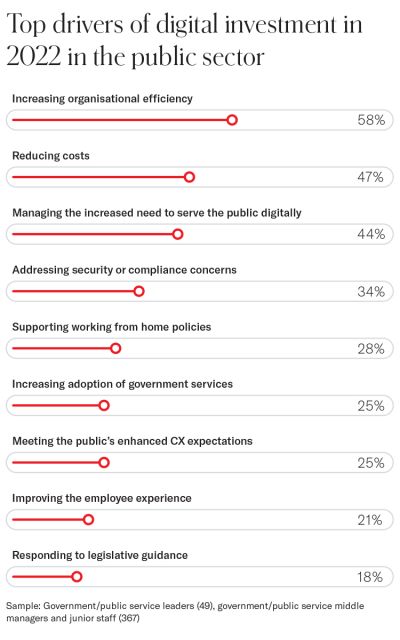Local governments and councils are facing unprecedented challenges because of increased digitalisation. Outdated systems and paper documents slow down processes and make it difficult to meet the demands of constituents, but budget constraints can make IT upgrades a challenge.
However, digital transformation is not always as daunting as it seems: the pivot to a digital workplace brought about by the Covid-19 pandemic demonstrated that digital technology can improve service delivery, with positive outcomes for both customers and employees. Digital service delivery became key to business continuity for local governments, prompting developments in sectors that were previously lagging, such as libraries and community support.
Global research is increasingly focusing on the benefits of digital transformation in local governments and the public sector, highlighting how technology can create a more sustainable future and meet the needs and expectations of different communities.
According to the Digital Trends 2022 Public Sector Report by Adobe, only 14% of public service and government respondents believe the digital experience they offer is ahead of the public’s expectations. This shines a light on the need to create efficient digital services and infrastructures, especially at a local government level.
This insight explores the advantages of digitalising the public sector, detailing 10 reasons local governments should embrace digital transformation.

Data from Adobe Digital Trends 2022 - Public Sector in Focus
1. Provide more efficient digital services for constituents
In the digital age, customers expect to be able to access local council services on mobile just as easily as they order food or book a train ticket. The idea of government as a service has become increasingly prevalent after Covid-19, when everything became readily available with the touch of a button. Providing constituents with on-demand access to applications and information is the first step to effective digital transformation.
Digitising operations such as parking permit purchases, claims and applications saves employees time and leads to customer satisfaction as it decreases processing times. According to the Digital Data, and Technology Playbook published by the UK Government in March 2022, digital technologies have improved service delivery in various departments, notably DVLA, HMRC and NHS.
Customer feedback is essential to the steady improvement of digital services. Modern technologies allow institutions to easily collect feedback through short online surveys and contact forms. Encouraging citizens to provide feedback and acting on it increases trust and enhances the credibility of local authorities.
2. Achieve carbon net zero and social value
Social and environmental value is an integral element of business growth after digital transformation, especially in the public sector. Reducing carbon emissions by 78% by 2050 is one of the main goals set by the UK government; adopting digital technology allows for the implementation of waste management and energy-saving plans which could make a difference towards achieving carbon neutrality.
3. Improve accessibility and inclusion
Providing services that are accessible to audiences with diverse needs and abilities is crucial to gaining the public’s trust and ensuring equal opportunities. Digital transformation allows local governments to think about inclusion strategies which might include bridging the digital divide and implementing assistive technology tools in their services.
It is important to remember that racialised and marginalised communities are disproportionately negatively affected by the increased use of digital technology. Research by the World Economic Forum highlights the necessity to design technology around the needs of individual communities to increase participation.
4. Protect data and focus on privacy
Investing in a good technology infrastructure allows the implementation of a reliable security management system. This is especially important in the public sector and at local government level, where a data breach could put the people whose data have been compromised at risk (for example victims of domestic violence or individuals in the care system).
Taking all the necessary steps to integrate privacy protection as an essential part of government systems means that local authorities will be less likely to incur in breaches of GDPR (General Data Protection Regulation).
Additionally, the use of digital technology to implement automated data management ensures greater transparency. This includes making publicly available information searchable in a database. Automated workflows also encourage transparency in government processes, notifying constituents when each step is completed.
5. Improve cyber security
Similarly, digital transformation allows for improvements to internal IT security for local governments. For example, implementing a good cloud system improves the quality and safety of services, and relying on software as service (SaaS) solutions protects technology systems.
6. Facilitate collaborating and sharing data and services in a digital workplace
Working together is essential at all levels in the public sector, in order to quickly solve issues and overcome challenges. In technology procurement, upgrading networks and using platforms for collaboration avoids unnecessary duplication and expenditure.
7. Make better use of data by improving technology infrastructure
This is essential for both constituent-facing services and internal processes. Adapting your technology infrastructure so that it integrates with the most recent software and applications ensures continuity of service while reducing long-term IT support costs.
8. Open remote job opportunities in local authorities
By implementing an effective IT infrastructure that ensures operational resilience and cyber protection, local governments can open new job roles that are partially or entirely remote. This allows to retain talent regardless of geographic location and creates a more inclusive workplace.
9. Cut costs and generate new revenue
Digital transformation enables cost savings while simultaneously generating additional revenue streams. The digitisation of services means money is no longer spent on unnecessary resources, and improved data analysis through automation allows local governments to identify new areas with potential for revenue.
For example, Newcastle City Council developed SMS-based chatbots that allow residents to apply for permits to access recycling centres. The ‘Wastebot’ decreased processing times from an average of 14 days to just 90 seconds. As well as improving customer experience, these digital solutions help to cut costs significantly – like the Bin Information Bot that generated £500k in savings by providing real-time information about bin collections.
10. Streamline back-office work and customer service with SaaS and task automation
Automating simple tasks as well as document management produces quicker and higher-quality results, minimising the need for manual data management. As a result, employees' internal departments such as finance and human resources can run smoothly and, in turn, ensure quicker customer service.
Automation and artificial intelligence also ensure the personalisation of services to citizens and enable them to access what they need by themselves, without needing to contact operators. This allows for resources to be directed where human interaction is still necessary.
For example, Leeds Council launched a web chat service enabling users to find information quickly and guiding them through processes. Replacing phone calls with web chats generated about £18k in savings over a period of eight months, and 80% of users reported that their enquiry was resolved successfully.

"We have seen a significant trend with local government clients vs. clients in almost every other industry vertical of local government being far behind the curve. This means it is far more statistically likely for the customers of local government organisations to work in industries that are advancing digitally at a faster rate. In our experience, this has led to a real disconnect between the expectations of the public and the services LGOs are delivering. Over half of the consultations with our LGO clients have related specifically to either tackling or preparing to tackle exactly this challenge. Digitisation of old paper records, the design and construction of data lakes and data warehouses to inform better internal data analysis, as well as providing data science services are all common engagements." - Andy Murtagh, Chief Service Officer at ROCK
Conclusion: revolutionising the public sector with digital technology
The public sector, especially local governments, have been slow to adapt to digital technologies. While the Covid-19 pandemic sped up the process of digital transformation, a cultural shift is still needed to realise the advantages of digital technologies.
As highlighted in the UK Government Digital, Data and Technology Playbook, taking an outcome-based approach to implementing digital technologies is essential to the effective delivery of services focused on user needs. This entails tackling the technical debt, maintaining cyber security and enabling continuous innovation through technological improvements. Digital workplace solutions also empower employees to better serve their communities.
Collaboration is the key to achieving this. Along with taking full advantage of existing products and services, local governments and the public sector also need to develop in-house digital capabilities by ensuring that the necessary skills are acquired at all levels.
Implementing a first-class IT infrastructure, paired with a suitable cyber security and data management strategy empowers public servants to focus on local communities. Simultaneously, a good digital transformation strategy should strive to support vulnerable citizens and workers who are unable to engage with digital technologies.
The promise of digital transformation can create impactful and lasting change, which is why it is essential to support government investment in technology. With passion, collaboration, and a good digital transformation roadmap, we can empower local governments to provide the best services, and citizens to create a better world.
References
- Adobe (2022) Digital Trends: Public sector in focus. Adobe Business 2022. [Accessed: 21 July 2022].
- Bemrose, D. (2022) Digital transformation in the future of local government. Open Access Government 20 May 2022. [Accessed: 19 July 2022].
- Central Digital and Data Office (2021) The technology code of practice. UK Government 14 July 2021. [Accessed: 19 July 2022].
- GovNet (2022) What does digital innovation in local government look like? GovTech 2022. [Accessed: 21 July 2022]
- HM Government (2022) The digital, data and technology playbook. HM Government March 2022. [Accessed: 20 July 2022].
- Jansen Reventlow, N. (2021) Why tech needs to focus on the needs of marginalised groups. World Economic Forum 8 July 2021. [Accessed: 25 July 2022]
- Marsden, P. and Al-Hillawi, E. (2022) Digital transformation: reshaping local government. Government Business April 2022. [Accessed: 19 July 2022]
- Murray, A. (2022) Capita: We do not need more technology. TechUK 1 July 2021 [Accessed: 12 July 2022]